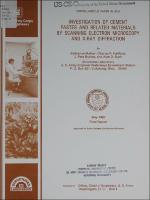Please use this identifier to cite or link to this item:
https://hdl.handle.net/11681/11118| Title: | Investigation of cement pastes and related materials by scanning electron microscopy and x-ray diffraction |
| Authors: | Mather, Katharine Hallford, Charles R. Burkes, J. P. Buck, Alan D. |
| Keywords: | Cement pastes Electron microscopy Petrographic analysis X-ray analysis X-ray diffraction Concrete |
| Publisher: | Structures Laboratory (U.S.) Engineer Research and Development Center (U.S.) |
| Series/Report no.: | Miscellaneous paper (U.S. Army Engineer Waterways Experiment Station) ; SL-83-6. |
| Description: | Miscellaneous Paper Abstract: Five samples were examined after hydration by scanning electron microscopy (SEM) and both before and after hydration by X-ray diffraction to establish microstructural and compositional data. The majority of the work was done on hydrated material. These samples consisted of three non-expansive cementitious and two expansive cementitious materials. The three non-expansive cementitious materials were an alite, a Type I portland cement, and a Type V portland cement. The two expansive cementitious materials were an ettringite-forming material and a Type K expansive cement. The X-ray diffraction data were used as a guide to interpret SEM micrographs since this SEM unit does not have an attached X-ray detector to provide compositional data. Another means of identifying material in the SEM micrographs was by comparison with published micrographs of similar materials. This proved satisfactory to a greater degree than had been expected. The micrographs obtained in the present work were to be used as a basis for identifying similar products in other micrographs. The Type I and Type V portland cements developed a dense and compact microstructure at early ages whereas the other three materials showed open, porous microstructures at all ages examined (7 to 28 days). The other substantial difference was that the three non-expansive cementitious materials developed and showed conspicuous amounts of calcium silicate hydrate (CSH) whereas the two expansive materials developed abundant ettringite instead of abundant and evident CSH. |
| Rights: | Approved for public release; distribution is unlimited. |
| URI: | http://hdl.handle.net/11681/11118 |
| Appears in Collections: | Miscellaneous Paper |
Files in This Item:
| File | Description | Size | Format | |
|---|---|---|---|---|
| MP-SL-83-6.pdf | 7.83 MB | Adobe PDF |  View/Open |